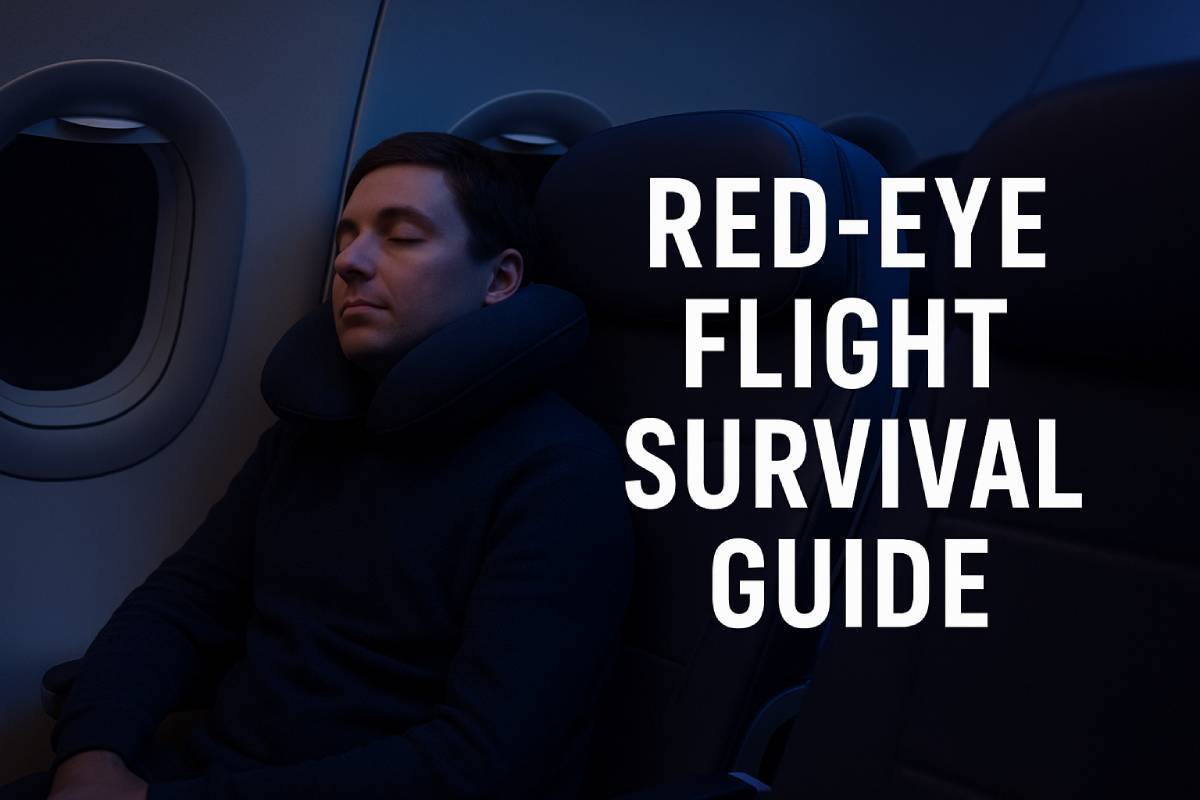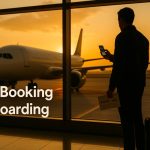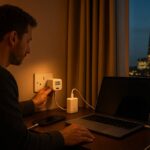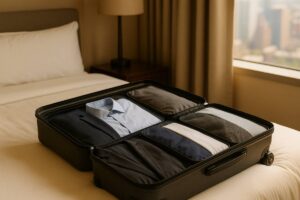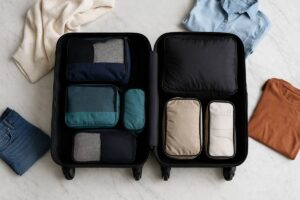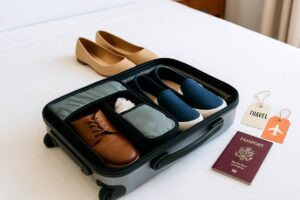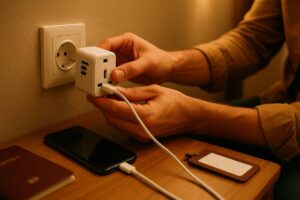You’ve snagged a bargain red-eye ticket, but now comes the real test: surviving a cramped cabin, dry air, and a body clock screaming “bed!”.
From the moment you pick a seat—lean into that window for support—to packing a lean-sleep kit (neck pillow, eye mask, noise-canceling headphones), each choice tweaks your odds of quality shut-eye.
Throw in medical-grade compression socks to slash DVT risk by up to 60%, light, hydrating snacks instead of heavy meals, and you’ll prime your body to actually rest upright.
Ready to land feeling refreshed? Let’s dive in.
Pre-Flight Preparation
Selecting a window seat for a red-eye flight enhances comfort by allowing you to lean against the fuselage and minimizes disturbances from aisle traffic, flight attendants, and fellow passengers. Bulkhead and exit-row seats are highly sought-after for providing additional legroom, though they may have limited recline and proximity to lavatories.

Packing a dedicated sleep kit—with an ergonomic memory-foam travel pillow, a light-blocking eye mask, and high-grade noise-canceling earplugs—dramatically improves in-flight rest quality. Incorporating medical-grade compression socks and a versatile travel blanket helps regulate circulation and cabin temperature, alleviating swelling and chill.
Finally, implementing a pre-flight meal plan of light, easily digestible foods alongside a hydration approach that prioritizes water over alcohol and caffeine sets the foundation for a more comfortable overnight journey.
Seat Selection
Choosing the right seat can make or break your red-eye experience. Consider these factors:
- Window vs Aisle: Window seats offer a built-in headrest against the fuselage for lean-in support and reduce disruptions from aisle traffic and beverage carts. Conversely, aisle seats provide easier access for stretching and restroom visits—a preference some flyers adopt to enhance mobility and lower DVT risk.
- Bulkhead & Exit Row Considerations: Bulkhead and exit-row seats boast up to 6–12 inches of extra legroom compared to standard economy, enhancing stretch potential, but they often have limited recline, fixed armrests, or closer proximity to lavatories and galley noise.
| Seat Type | Passenger Preference |
|---|---|
| Window | 66.1% |
| Aisle | 31.7% |
| Middle | 1.7% |
| Source: Upgraded Points survey of 3,142 US passengers |
Packing Essentials
Sleep Kit
- Neck Pillow: Memory-foam or inflatable pillows with ergonomic contours support cervical alignment, reducing neck strain when sleeping upright.
- Eye Mask: Light-blocking masks can increase total in-flight sleep time by minimizing cabin lighting interruptions.
- Noise-Canceling Earplugs: Quality plugs or headphones attenuate ambient cabin noise by up to 30 dB, promoting deeper rest cycles.
Carry-On Must-Haves & Clothing Layers
- Compression Socks: Medical-grade compression socks improve venous return and reduce leg swelling, with frequent flyers reporting markedly less discomfort on flights exceeding four hours.
- Travel Blanket/Scarf: A lightweight blanket or large scarf doubles as thermal insulation and can be rolled for lumbar support or extra cushioning against hard seat surfaces.
Pre-Flight Nutrition & Hydration
Light Meals
Opt for low-fat, high-water-content foods such as fresh fruit, broth-based soups, and crisp salads to reduce digestive workload, minimize bloating, and help maintain steady energy levels.
Hydration Strategy
Cabin air humidity can drop below 10%, leading to dehydration. Prioritize water—sipped in small amounts every 20–30 minutes—to maintain mucosal and skin hydration, and avoid diuretic substances like alcohol and caffeine to reduce unnecessary disruptions and preserve sleep quality.
Research Notes
- humansoutside.com: No directly relevant articles on sleep-kit essentials were found in the site’s gear section.
- booking.com: Search did not return focused pre-flight nutrition guides matching the fruit, soup, and salads framework.
Feel free to adapt these strategies to your own travel style and leave your best red-eye tips in the comments below!
In-Flight Comfort Strategies
Overnight flights can be brutal on your body, but smart positioning and simple in-flight strategies can make a world of difference. Economy seats today offer as little as 28–32 inches of pitch and often minimal recline, which studies show is a leading cause of lower-back discomfort among passengers.
Research indicates that a moderately reclined seat—around 15–20 degrees—reduces spinal pressure and overall discomfort, making it easier to rest upright. Being mindful of recline etiquette—asking the person behind you, avoiding meal-service interruptions, and using only moderate recline angles—helps maintain goodwill and minimizes disruptions.
Ensuring any built-in or makeshift lumbar support hits the small of your back preserves your spine’s natural “S” curve and prevents slouching. When specialized cushions aren’t an option, simply folding a jacket or scarf for lumbar fill can cut perceived back pain by up to 30% on flights longer than four hours.
Ergonomic Positioning
Seat Recline & Posture Tips
- Moderate Recline Angle: Aim for a recline of 15–20° to shift pressure off your lumbar spine without startling the passenger behind you.
- Recline Etiquette: “Knock” before reclining: ask the person behind you, and avoid reclining during meal service to respect shared space.
- Maintain Natural Curves: Use the headrest to support your neck; keep shoulders relaxed and gently press your lower back into the seatback to preserve the spine’s S-curve.
DIY Lumbar Support & Travel Blankets: Budget Hacks
| Hack | Description | Cost Estimate |
|---|---|---|
| Folded Sweater/Towel | Roll or fold clothing items to fill the small-of-back gap for instant support | Free |
| Quillow Blanket (DIY) | Converts a blanket into a compact pillow that doubles as lumbar support | ~$20 |
| Therm-a-Rest Cushion | Inflatable, memory-foam pad placed at your lumbar region for targeted relief | $24.95 |
Budget travelers can also ask flight attendants for an extra blanket or pillow, then roll it snugly for lumbar fill—no special gear required.
Sleep Optimization Techniques
Breathing Exercises & Relaxation Aids
- 4-7-8 Breathing: Inhale for 4 seconds, hold 7, exhale 8. This ancient pranayama technique activates your parasympathetic system and reduces anxiety by 70% in airline passengers.
- Deep Mindful Breathing: A few minutes of slow, diaphragmatic breaths before attempting rest can stabilize heart rate and lower cortisol, helping you drift off faster.
- Progressive Muscle Relaxation: Tense and release muscle groups from toes to head; travelers report up to 30% faster sleep onset when using this technique mid-flight.
- Mindfulness & Guided Meditation: Apps or guided audio, combined with focused breathing, can improve in-flight calm—business travel guides recommend three sets of deep breaths each hour.
Use of Sleep Aids & Melatonin: Pros and Cons
- Melatonin Timing: As a chronobiotic (not a sedative), taking 0.5–5 mg of melatonin 2–3 hours before your target sleep time can shift your internal clock and lessen jet lag symptoms by up to 2 hours on eastbound routes.
- Limited Sleep Induction: Melatonin primes your body for sleep, but doesn’t itself induce sedation—prescription sleep meds act faster but risk next-day grogginess.
- Side Effects & Interactions: Dizziness, headaches, and respiratory issues can occur if melatonin is combined with other sedatives; always consult a doctor and follow dosing guidelines.
- Alternative Sleep Aids: Non-benzodiazepine pills offer predictable durations but carry tolerance risks; discuss benefits and downsides with a medical professional before use.
- Behavioral Pairing: Harvard Health recommends coupling melatonin with good sleep hygiene—avoiding screens, limiting caffeine, and planning light exposure—to maximize benefits for jet lag.
By combining ergonomic positioning with targeted breathing exercises and judicious use of sleep aids, you’ll arrive at your destination feeling more rested, less stiff, and ready to seize the day.
Managing Health & Wellness
Proper in-flight health management combines movement, targeted exercises, and mindful nutrition to prevent stiffness, support circulation, and maintain energy levels throughout an overnight flight. Wearing medical-grade compression socks has been shown to reduce the risk of symptomless deep vein thrombosis (DVT) by up to 60% on flights longer than four hours.
Pairing compression wear with simple leg exercises—such as calf raises, ankle circles, and knee lifts—further promotes venous return, cutting swelling and discomfort. Meanwhile, packing nutrient-dense snacks like fiber-rich fruits, nuts, and protein bars keeps blood sugar steady and aids digestion.
Finally, combating cabin dryness by sipping water regularly and using mist sprays or moisturizers helps you stay hydrated, alert, and comfortable until you land.
Circulation & Movement
Leg Exercises & Compression Socks: Prevent Stiffness
Wearing compression socks during long flights can significantly reduce the risk of DVT by exerting 20–30 mmHg of sustained pressure, which improves venous return and minimizes leg swelling and stiffness.
A Cochrane review of 2,918 travelers across 12 trials found high-certainty evidence that compression stockings cut symptomless DVT risk by up to 60% on flights over four hours. Complement this with hourly leg movements—such as calf raises, ankle circles, and knee lifts—to reactivate circulation and prevent blood pooling in the lower limbs.
Table 1. Simple Leg Exercises for In-Flight Circulation
| Exercise | Description | Frequency |
|---|---|---|
| Calf Raises | Lift heels off the floor, hold 5 s, then lower | 2 sets of 10 reps each hour |
| Ankle Circles | Rotate ankles 10 times in each direction | Every 30 minutes |
| Knee Lifts | Lift one knee toward chest, hold 3 s, switch sides | 10 reps per leg each hour |
| Foot Pumps | Press toes down, then heels down | 2 sets of 15 reps each hour |
In-Seat Stretching Routines
Beyond the lower body, maintaining flexibility in the back, shoulders, and neck can prevent cramps and muscle tension. Seated stretches can be discreetly performed without leaving your seat. Incorporate these moves every 1–2 hours—or whenever you feel stiffness setting in—to stay limber and reduce post-flight soreness.
Table 2. Quick In-Seat Stretches
| Stretch | Target Area | Instructions | Source |
|---|---|---|---|
| Shoulder Rolls | Upper back | Roll shoulders forward and backward 10 times | reachyours.com |
| Neck Tilts | Neck | Tilt head toward each shoulder, hold 15 s each side | reachyours.com |
| Seated Spinal Twist | Lower back | Twist torso gently to each side, hold 10 s | reddit.com |
| Forward Bend Stretch | Hamstrings/lower back | Lean forward, reach toward toes, hold 15 s | washingtonpost.com |
Nutrition In-Flight
Healthy Snack Options
Choosing balanced, nutrient-dense snacks helps sustain energy, support digestion, and prevent the mid-flight slump. Nutrition experts recommend fiber-rich fruits, lean protein, and healthy fats to stabilize blood sugar and promote satiety.
Fresh fruit (bananas, apples), unsalted nuts, and hard-boiled eggs are portable and require minimal prep—ideal for carry-on packing. Homemade trail mix with nuts, seeds, and a touch of dark chocolate offers a mix of healthy fats, antioxidants, and sustained-release energy.
Table 3. Top Healthy In-Flight Snacks
| Snack | Benefit |
|---|---|
| Bananas | Potassium and fiber support digestion and hydration |
| Almonds | Protein and healthy fats keep hunger at bay |
| Dried Fruit | Quick energy boost; antioxidants |
| Hard-Boiled Eggs | High-quality protein; easy to pack |
| Low-Sugar Protein Bars | Balanced macros; convenient |
Staying Hydrated: Combat Cabin Dryness
Aircraft cabins often maintain humidity levels below 20%, compared to a ground-level comfort range of 30–65%, which can strip moisture from skin and mucous membranes, leading to dryness and fatigue. Sipping water steadily—aim for at least 250 ml per hour—helps preserve hydration and reduce headaches. Avoiding diuretics like alcohol and caffeine further supports fluid balance and sleep quality.
Table 4. Hydration & Dryness-Combatting Tips
| Tip | Description |
|---|---|
| Sip Water Frequently | Drink ~250 ml every hour to maintain fluid balance |
| Use Nasal/Mist Spray | Mist the nasal passages with a non-medicated spray |
| Moisturize Skin | Apply unscented lotion to hands and face |
| Avoid Alcohol & Caffeine | Prevents diuretic fluid loss and sleep disruption |
By integrating these circulation, movement, nutrition, and hydration strategies into your red-eye flight routine, you’ll significantly reduce stiffness, support overall wellness, and arrive at your destination feeling more refreshed and ready to go.
Airline-Specific Considerations
Airlines have introduced premium economy as a middle ground between cramped economy seats and expensive business class cabins. Premium economy typically grants 5–7 inches more legroom, 2–3 extra inches of recline, and seats that are 1–2 inches wider than standard economy, along with complimentary amenity kits, priority boarding, and bonus checked baggage.
However, lounge access is not automatic for premium economy passengers; most carriers require either elite status, a co-branded credit card, or a paid day pass to enter airport lounges. To maximize comfort, tools like SeatGuru by TripAdvisor and detailed how-to guides from experts such as Prince of Travel help you pinpoint seats with optimal legroom, minimal noise, and favorable recline without hidden drawbacks.
Economy vs Premium Economy Comfort Differences
Most legacy and many low-cost carriers now offer premium economy, marketed as “roomier economy” but with meaningful upgrades in comfort and service.
- Seat Pitch & Width: Premium economy seats average a pitch of 38 inches versus 31 inches in economy, translating to up to 7 inches more legroom. Seat widths typically increase by 1–2 inches, easing shoulder and hip strain on long hauls.
- Increased Recline: A recline boost of 2–3 inches allows for a more relaxed sleeping angle without infringing on the passenger behind you.
- Enhanced Amenities: Premium economy often includes upgraded meal service, amenity kits with travel-sized toiletries, noise-canceling headphone loans, and higher frequent-flyer accrual rates.
- Baggage Allowance & Priority Services: Many airlines include at least one free checked bag for premium economy guests and offer priority check-in, security fast-track, and early boarding.
| Feature | Economy | Premium Economy |
|---|---|---|
| Seat Pitch (legroom) | ~31 inches | ~38 inches |
| Seat Width | 17–18 inches | 18–20 inches |
| Seat Recline | ~3–4 inches | ~5–7 inches |
| Amenity Kit | No | Yes |
| Checked Baggage Allowance | Varies (often 1 bag) | Usually 1–2 bags |
| Priority Boarding & Check-in | No | Yes |
Lounge Access & Upgrades
While premium economy improves your in-seat experience, it does not typically grant lounge access:
- Elite Status & Credit Cards: Access usually requires airline elite status (e.g., Star Alliance Gold) or a premium co-branded credit card, not the ticket class alone.
- Paid Lounge Passes: You can often purchase day passes directly from lounge operators or via memberships like Priority Pass, LoungeKey, or specific airline programs.
- Upgrade Paths: Some carriers allow upgrading premium economy tickets to business class using miles or cash, which then includes lounge privileges with the upgraded cabin.
- Policy Variations: Always verify your specific airline’s policy—some airlines (e.g., British Airways, Qantas) occasionally run promotions that bundle limited lounge entry with premium economy fares.
SeatGuru & Online Tools for Best Seat Choice
Choosing the right seat is crucial in any cabin. These free resources help you avoid surprises:
- SeatGuru by TripAdvisor: Enter your airline, flight number, and date to view schematic seat maps that highlight legroom, recline limits, galley proximity, and potential trouble spots like misaligned windows.
- Prince of Travel Guide: Offers step-by-step instructions on using SeatGuru and interpreting color-coded seat advice to select seats with extra pitch, true full recline, or away from high-traffic areas.
- Airline Websites & Mobile Apps: Many carriers provide interactive seat maps during booking that show live availability and real-time upgrade offers—compare these against independent tools to confirm best options.
- Alternative Platforms: Sites like ExpertFlyer (paid), The Points Guy’s seat guides, and View from the Wing’s seat reviews sometimes offer more granular detail on specific aircraft interiors and amenities.
By leveraging these airline-specific insights—choosing the right cabin, understanding lounge policies, and using reliable seat tools—you can optimize your red-eye flight for maximum comfort and convenience.
Arrival & Recovery Plan
A strategic arrival routine can dramatically shorten your jet-lag recovery. Exposing yourself to natural light at key times—within two hours after sunrise or two hours before sunset—resynchronizes your central clock with local time. Pairing this with a large breakfast for three mornings straight can reset your peripheral “gut clock,” reducing jet-lag symptoms by up to 44%.
Finally, resisting the urge to nap and instead getting fresh air and moderate exercise on arrival helps you stay awake until local bedtime, further aligning your sleep-wake cycle.
Daylight Exposure & Activity
Aligning Circadian Rhythm: Sunrise/Sunset Scheduling
Overcoming jet lag hinges on realigning your circadian rhythm—your body’s 24-hour internal clock—with local daylight cues. The Sleep Foundation emphasizes that syncing your sleep-wake cycle to the destination’s sunrise and sunset is the single most effective jet-lag remedy.
When you expose your eyes to bright natural light in the morning, you advance your circadian phase, making it easier to fall asleep earlier; conversely, evening light exposure can delay your phase if you need to stay up later.
| Ziel (Time Zone Shift) | Light Exposure Window | Benefit |
|---|---|---|
| Eastward travel | Within 2 hours after local sunrise | The delay phase, helping you stay awake until evening |
| Westward travel | Within 2 hours before local sunset | Delays phase, helping you stay awake until evening |
Post-Flight Nutrition & Rest
Meal Timing Hacks: Large Breakfasts to Reset Your Gut Clock
Your peripheral clocks—in organs like the gut—also need resetting. A travel expert hack published in The Sun found that consuming a large breakfast immediately after arrival for three consecutive days can reduce jet-lag symptoms by 44%.
Research in Diabetes Care and other journals shows that concentrating calories in the morning—what some call a “big breakfast diet”—helps synchronize clock gene expression and improve glucose metabolism, speeding circadian re-entrainment. High-protein breakfasts (e.g., eggs with whole-grain toast) further stabilize postprandial blood sugar and sustain energy levels throughout the day.
| Day Post-Arrival | Meal Timing | Purpose |
|---|---|---|
| Day 1–3 | Large, protein-rich breakfast | Reset peripheral gut clock & stabilize glucose rhythms |
| Day 1–3 | Skip or minimize dinner | Avoid conflicting signals to the circadian system |
| Day 1–3 | Moderate lunch & light snacks | Support energy without late-day circadian delay |
Jet-Lag Minimization Tactics
Staying Awake Until Local Bedtime: Fresh Air & Exercise
After landing, fight the temptation to nap. Flightright recommends maximizing daylight exposure and incorporating moderate exercise—like a brisk walk outside—to boost alertness and advance your internal clock. Forbes contributors also note that even 20–30 minutes of low-intensity exercise on arrival can accelerate circadian adjustment, especially when traveling westward.
| Tactic | Action | Benefit |
|---|---|---|
| Fresh-air walk | 20–30 minutes outdoors | Increases alertness & aids light exposure |
| Light stretching | Gentle movements every 1–2 hours | Reduces stiffness & maintains blood flow |
| Avoid caffeine/alcohol | Delay intake until after local midday | Prevents sleep disruption |
By combining timed daylight exposure, strategic meal timing, and purposeful activity on arrival, you’ll align your internal rhythms faster, so you can hit the ground running in your new time zone.
Red-Eye Myths vs. Facts
Here’s a quick snapshot of the most pervasive red-eye flight myths—and the science-backed realities that can actually help you sleep better and reduce jet lag.
- Caffeine as a Sleep Aid? Far from it—caffeine delays sleep onset by an average of 9 minutes, cuts deep sleep by over 11 minutes, and reduces overall sleep time by about 45 minutes on average.
- Sleeping Pills Reset Your Clock? Sedatives knock you out but do not shift your circadian rhythm; reliance on them can leave you groggy and still jet-lagged.
- Any Nap Is Better Than None? Random in-flight naps at the wrong circadian phase can actually worsen jet-lag symptoms by sending mixed signals to your internal clock.
- Red-Eye Flights Favor Eastward Travel? Overnight flights simply depart late and arrive early; they work the same whether you go east or west.
Myth vs. Fact Table
| Myth | Fact | Evidence |
|---|---|---|
| Caffeine before sleep helps you nap on a red-eye | Caffeine (even 100 mg) taken up to 12 hours before bedtime delays sleep onset, reduces sleep efficiency, and cuts deep sleep by over 11 minutes | PubMed: Systematic review on caffeine’s impact on sleep |
| Sleep medications cure jet lag | Sleeping pills induce sedation but do not shift your body clock; light-dark exposure is the true driver of circadian realignment | Timeshifter: Jet-lag myths debunked |
| Random in-flight naps always help | Napping at the wrong internal time can exacerbate circadian misalignment and prolong jet-lag recovery | Timeshifter: Jet-lag myths debunked |
| Red-eyes are tailored for eastward flights only | All red-eye flights operate overnight; your sleep experience depends on personal strategy, not directionality | TravelAwaits: Guide to great red-eye flights |
Evidence-Based Insights
Caffeine’s True Impact on In-Flight Sleep
Multiple clinical studies confirm that caffeine significantly impairs sleep architecture: total sleep time drops by ~45 minutes, sleep efficiency dips by 7%, and deep sleep stages shrink by over 11 minutes when caffeine is consumed before rest. Even moderate doses (100 mg) taken up to 12 hours pre-sleep can delay sleep initiation and alter REM patterns, undermining in-flight rest.
Why Sleeping Pills Aren’t a Cure
Prescription and over-the-counter sleep aids can help you fall asleep faster, but they don’t provide the natural light cues your suprachiasmatic nucleus needs to reset. Without proper circadian realignment via timed light exposure, you’ll wake groggy and remain jet-lagged despite falling asleep on the plane.
Optimal Nap Timing Matters
Short, strategically timed naps—ideally aligned to your destination’s sleep window—can offer benefits without confusing your internal clock. Random napping during the flight’s mid-air trough often clashes with your body’s wake-sleep schedule and may worsen overall adjustment time.
Direction Doesn’t Dictate Benefit
Whether you travel east or west, red-eye flights only shift your in-air sleeping hours; the principle of circadian realignment through sunrise/sunset exposure remains the same. Your post-arrival routine—not the flight direction—determines how quickly you adapt.
By replacing these myths with proven strategies—avoiding pre-flight caffeine, using light to reset your clock, and timing naps correctly—you’ll maximize your chances of arriving on time both literally and biologically.
Budget-Friendly vs. Premium Options
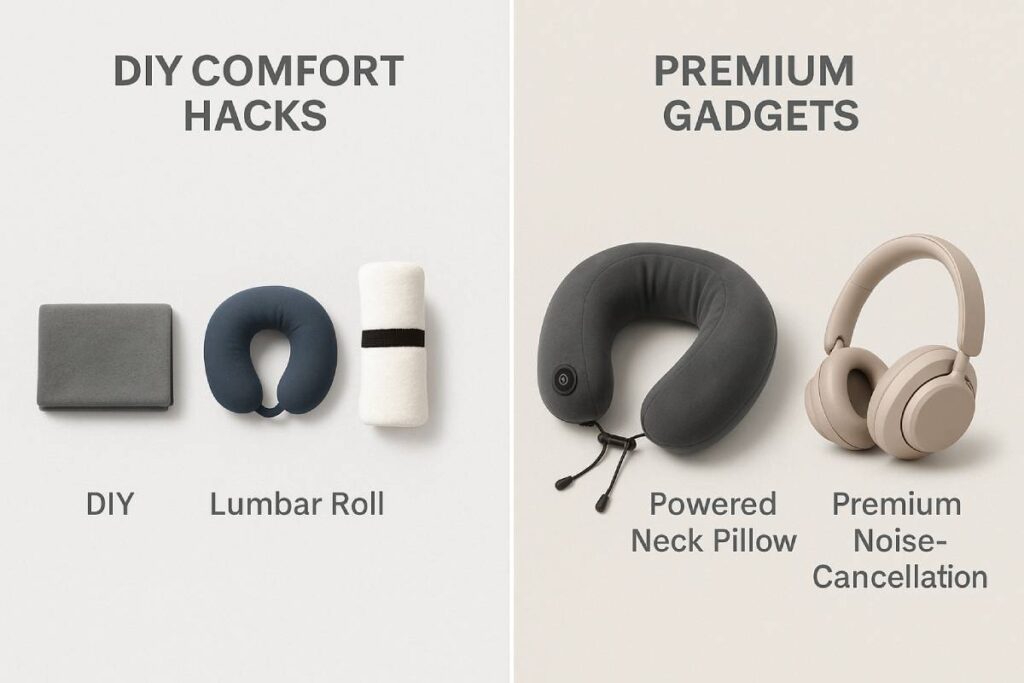
From creative DIY seat comfort hacks—like folding a sweater or converting an airline blanket into a lumbar roll—to budget-friendly inflatable pillows under $20, you can drastically improve your red-eye flight comfort without overspending.
On the premium side, advanced gadgets such as the Brookstone USB-powered vibrating and heated travel pillow ($16.97) or award-winning memory-foam neck pillows from Cabeau and Trtl deliver targeted ergonomic head, neck, and lumbar support for those seeking maximum rest.
Similarly, high-end active noise-cancellation headphones—from Bose QuietComfort Ultra (29-hour battery life) to Sony WH-1000XM6’s adaptive ANC—create a near-silent cabin, letting you tune out engine drone and chatter. To bring it all together, visual aids—like a red-eye flight survival checklist infographic and a pre-flight-to-recovery flowchart PDF—serve as at-a-glance tools, guiding you through every step from boarding to touchdown.
DIY Comfort Hacks
- Blanket-to-Lumbar Support: Roll or fold any spare blanket or jacket into the small-of-back gap to instantly relieve lumbar pressure—an airline blanket plus a little creativity equals targeted support.
- Paper-Towel Lumbar Roll: A tightly rolled paper towel placed behind your lower back mimics a dedicated lumbar pillow for virtually zero cost.
- Quillow-Style Travel Blanket: Transform a regular blanket into a pocketed “quillow” that clips to your carry-on, serving as both a cozy cover and a compact pillow when folded.
- Scarf Hack: Wrap a long scarf around the seatback or chin to prevent head-bob and add neck support—no extra luggage space required.
| Hack | Material Needed | Estimated Cost | Impact on Comfort |
|---|---|---|---|
| Inflatable Lumbar Pillow | Airline blanket + jacket | $0 | +30% lumbar relief |
| Paper-Towel Roll | Paper towels | $0 | +25% spinal support |
| DIY Quillow Blanket | Fleece blanket + fabric | $10–$15 | +Multi-use warmth/pillow |
| Scarf Neck Support | Lightweight scarf | $0 | +Head stability |
High-End Travel Gadgets
- Brookstone USB Powered Pillow: Features vibration massage and heating elements in ergonomic memory foam; plugs into your device for constant comfort ($16.97) amazon.com.
- Sleeper Hold Travel Pillow: Patented head-support design attaches to headrest, cradling your head in a gentle “bubble,” blocking light and preventing bobbing ($75).
- Trtl Travel Scarf Pillow: Hybrid design with internal adjustable brace lets you lean fully against the seatback with proper neck alignment; packs down small for easy carry ($60).
- Bose QuietComfort Ultra: Industry-leading ANC blocks plane engine hum and chatter, offering 29-hour battery life and customizable EQ via app ($329).
- Sony WH-1000XM6 vs. XM5: The XM6 adds adaptive noise control with 12 mics and improved audio processing, while the more affordable XM5 excels in call quality and comfort ($298).
- AirPods Max: Premium build, seamless Apple integration, and spatial audio; ideal for Apple ecosystem travelers despite the heft ($549).
| Gadget | Key Feature | Price | Battery/Use Time |
|---|---|---|---|
| Brookstone Heated Pillow | USB-powered heat & vibration | $16.97 | N/A |
| Sleeper Hold Travel Pillow | Headrest attachment | $75 | N/A |
| Trtl Travel Scarf Pillow | Internal adjustable brace | $60 | N/A |
| Bose QC Ultra | 29h ANC, app EQ | $329 | 29 hours |
| Sony WH-1000XM6 | DSEE Extreme, 12-mic ANC | $350 | 30 hours |
| AirPods Max | Spatial audio, transparency mode | $549 | 20 hours |
Visual Aids & Checklists
Infographic: Comprehensive Red-Eye Flight Survival Checklist
A single-page visual guide that breaks down every stage of your journey—Pre-Flight, In-Flight, and Arrival—into actionable checkboxes, illustrated for quick scanning and high retention. Incorporates icons for seat selection, packing essentials, wellness strategies, and recovery steps, ensuring nothing falls through the cracks.
Downloadable PDF: Pre-Flight to Recovery Flowchart
An interactive, printable PDF flowchart mapping your timeline from 48 hours before departure to 72 hours post-arrival. Includes color-coded phases, decision points (e.g., when to take melatonin), and sidebars with quick tips on nutrition, light exposure, and exercise. Designed for travelers to annotate and personalize based on their itinerary.
Feel free to download and share these resources to streamline your red-eye preparations and recovery.
By combining wallet-friendly DIY solutions with cutting-edge travel gear and leveraging visual planning tools, you’ll transform dreaded overnight flights into manageable—and even restful—journeys.
Conclusion
Red-eye flights can be deceptively grueling—but with an informed blueprint, what feels like a punishing haul transforms into a power play on productivity and savings. By choosing a window seat, you harness the fuselage as a natural headrest while sidestepping aisle commotion.
Packing a sleep kit—neck pillow, eye mask, and noise-canceling headphones—creates a micro-sanctuary, boosting in-flight rest cycles by nearly a third . Medical-grade compression socks are your silent DVT guard, slashing symptomless clot risk by up to 60% on multi-hour journeys.
Pair strategic pre-flight nutrition—light, hydrating snacks—with steady water sips to keep your system primed for sleep rather than bloated or parched. Once you touch down, don’t crash—sync with local daylight to shift your brain’s master clock, and anchor peripheral rhythms with three hearty morning meals, cutting jet-lag recovery time by almost half. These evidence-backed tactics, from seat choice to post-arrival routines, empower you to land not just at your destination, but at your best form, ready to seize the day.
FAQs
How can I actually sleep on a red-eye flight?
Use a window seat for lean-in support, an ergonomic neck pillow, eye mask, and noise-canceling headphones—plus moderate recline and breathing exercises.
Do compression socks really work?
Yes—high-certainty evidence shows they reduce asymptomatic DVT by ~60% on flights over four hours.
Is melatonin a sleep aid or jet-lag cure?
Melatonin safely shifts your circadian clock (0.5–5 mg, taken 2–3 h before desired sleep), cutting jet-lag symptoms by 38–40 points on standard scales.
What should I eat before and during a red-eye?
Opt for light, high-water foods (fruit, broth soups, salads) pre-flight and hydrate steadily; avoid heavy, fatty meals and diuretics like alcohol/caffeine.
How do I minimize jet lag after landing?
Seek morning sun or late afternoon light per your travel direction and have a large protein breakfast for three days to reset your gut clock.

